
“We don’t receive wisdom; we must discover it for ourselves after a journey that no one can take for us or spare us.”
- Marcel Proust
By Mike Darwin
A Digital Ark
A couple of years ago I did a “document dump” of scanned/digitized cryonics historical materials to the CryoEuro Wiki, which is hosted and maintained by Eugen Leitl (http://cryoeuro.eu:8080/pages/viewpageattachments.action?pageId=425990&startIndex=0). I’ve been scanning the cryonics historical material in my possession for about 4 years now. It is slow going and the results are often less than gratifying. I have 3 flatbed scanners at my disposal – two of which have been made ancient by the so far relentless march of Moore’s law. Still, they allow me the luxury of improving my efficiency a bit; while one scanner is arduously capturing a page and writing it to the hard drive, I can proceed to scan another page on another scanner.
I labor under such constraints because apparently (with the exception of Dr. Mike Perry) no one else gives a damn whether these resources survive or perish. Cynical words, I know, but also words that are true.
Why should anyone care? The past is the past and the science and technology of cryonics have moved on. The social, economic and political milieu that cryonics struggles in today is also greatly changed; perhaps so much so it might be argued, that the past is of relevance only as a curiosity, or as resource for future academics and historians of cryonics to use in writing learned dissertations and advancing peculiar theories about why things happened as they did, or turned out in the way they will? From my compromised vantage point (as a player in these events) it is hard for me to tell. My gut feeling is that the near complete absence of interest in this material, and in the historical epoch it chronicles, is a sign that something is wrong in cryonics. Or, maybe more accurately and promisingly, that something is simply missing at the moment.
 Figure 1: The build up and collapse of sand piles exhibit the property of surface fractals – also called cellular automata. The spikes (green) in the graph at the right of the illustration above show the ups and down of the sand pile’s height over time. The inset (blue) graph shows the Dow Jones Industrial Average during January of 2009. The similarity in the pattern of activity between the DJIA and the behavior of sand piles is almost certainly not a coincidence.
Figure 1: The build up and collapse of sand piles exhibit the property of surface fractals – also called cellular automata. The spikes (green) in the graph at the right of the illustration above show the ups and down of the sand pile’s height over time. The inset (blue) graph shows the Dow Jones Industrial Average during January of 2009. The similarity in the pattern of activity between the DJIA and the behavior of sand piles is almost certainly not a coincidence.
I think that most who seriously study the history of cryonics will conclude that there appear to be cycles of activism and interest. There is nothing remarkable in this: the same is true in almost any area of human undertaking, and of human history in general: peace-war, peace-war, boom-bust, boom-bust… Dribble grains of sand onto a sand pile and you’ll see a similar (if not identical) phenomenon. In fact, it seems to be a fundamental property of living systems. Physicists Per Bak, Chao Tang and Kurt Wiesenfeld noted that as grains of sand are randomly added to a sand pile and it experiences build ups and collapses, this behavior exhibits the property of surface fractals – also called cellular automata, with the “avalances” obeying the Eden Growth Model (Figure 1). This is the same rule that underlies the growth of bacterial colonies on an agar plate. In short, there is nothing mysterious about it. The overall pattern of build up and collapse over time looks much like like the Dow Jones Industrial Average over the period of a month or so (see blue insert graph in Figure 1). So goes sand piles, so goes cryonics and so goes the world.
Sand Piles & Soothsayers?
The Bak–Tang–Wiesenfeld sand pile model is lovely to know about, but it won’t help you pick a high performing stock, or even tell you what the market will do – beyond the fact that it will most likely exhibit behavior similar to that seen Figure 1 – except every great (and equally unpredictable) once in awhile, when it will behave very, very differently (so-called Black Swan events). Again, this is nice to know, but it is of little practical utility to the day trader, or the casual investor. And therein lies the rub – because we cryonicists are ostensibly in it for the long haul. And that’s where the history of cryonics becomes potentially very useful.
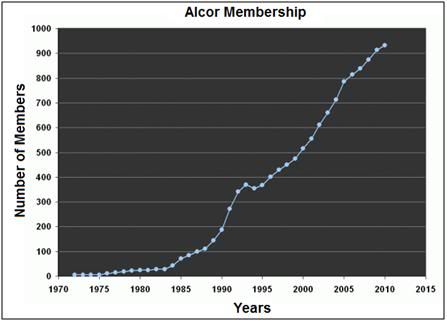 Figure 2: Alcor membership from 1972 to 2010. What can be learned from a careful analysis of these data? Is there a discernible reason(s) why growth in membership became nearly exponential, briefly, during the early 1980s?
Figure 2: Alcor membership from 1972 to 2010. What can be learned from a careful analysis of these data? Is there a discernible reason(s) why growth in membership became nearly exponential, briefly, during the early 1980s?
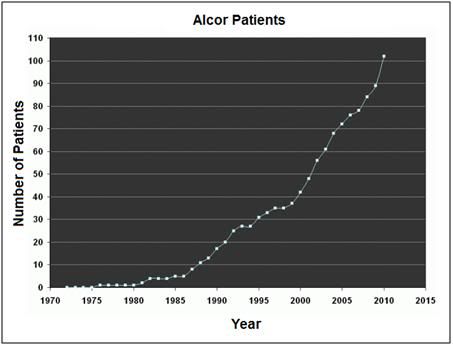 Figure 3: The Alcor patient population from 1975 to 2010.
Figure 3: The Alcor patient population from 1975 to 2010.
At the most basic level, it allows us to see what the pattern of activity has historically been like in cryonics. That does not necessarily mean that it will continue in the same way. However, there is now nearly 50 years of cryonics history. That’s a substantial baseline, and if you chart the progress of cryonics over that time by almost any measure, and you look at the primary historical record, you’ll immediately notice that in no way has cryonics behaved as it was predicted to do by the first generation of cryonicists (or for that matter, by any subsequent generation). There was no widespread “revolutionary” adoption of the idea, and if Alcor membership and patient statistics are examined, it is immediately apparent that growth was not only not logarithmic, it has been (mostly) linear (Figures 2 & 3). The Google N-gram for the frequency with which the word cryonics appears in published books (English language) similarly shows a lack of logarithmic growth (Figure 4).
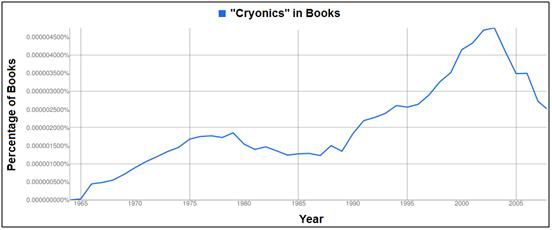 Figure 4: Google N-gram for the frequency with which the word “cryonics” appears in books published in the English language from 1964 to 2010. Does the shape of this curve reliably correlate with historical events in cryonics?
Figure 4: Google N-gram for the frequency with which the word “cryonics” appears in books published in the English language from 1964 to 2010. Does the shape of this curve reliably correlate with historical events in cryonics?
Beyond these basic observations, if we want to understand if there are any reasons for “bad” or “good” intervals on these, or other indices of how cryonics has performed over time, we will necessarily have to have recourse to history. Did anything happen of historical note to jump start Alcor’s growth in the 1980s? If so, what was it, and can anything be learned from examining the historical record in detail that might prove useful in assisting the growth of Alcor, and more generally the growth of cryonics, today? Do the pauses in growth and the occasional downturns that are in evidence to varying degrees in all of these charts mean anything? If so, are there lessons for us? What strategies were suggested (and tried) in the past, and did they work? Are the same kinds of errors being made now that were made a decade ago, or even 40 years ago? What kind of people, with what kinds of skills were responsible for growth spurts or paradigm shifts within cryonics? Indeed, what were the paradigm shifts, and did they matter?
 Figure 5: The rates at which novel consumer technologies were adopted in the United States.
Figure 5: The rates at which novel consumer technologies were adopted in the United States.
More generally, can we look to the ‘adoption curves’ of other technologies and draw any useful conclusions for cryonics? If nothing else, a quick glance at Figure 5 shows the profound delaying effect that the economic havoc of the 1929 stock market crash followed by the Great Depression and World War II had on some, but not all technologies. Are there implications for cryonics in such metrics both now, and in the future?
I don’t know the answers to these questions with certainty. But I do know, from experience, that carefully studying what worked and what didn’t, and paying close attention to membership and patient growth curves (not just in Alcor, but in cryonics as a whole) was essential to the success that Alcor enjoyed from ~ 1981 to ~ 1990. These data were critical in shaping the decisions that I and others made during that interval.[1] As George Santayana famously said, “Those who cannot remember the past are condemned to repeat it.”
Leaving aside the practical utility of the historical record of cryonics, I believe it is both fascinating and rewarding to peruse. It is also part of our duty as cryonicists to be aware of our history and to hold gratitude for, and give credit to those who worked to create it. Imagine waking up one day to find that all but the barest memory of your past had vanished? You know your name, where you work, perhaps where you were born, most of the things you need to get through the day; but nothing of where you came from, or what your experiences were 5 years ago, let alone 10, 15 or 20 years previously. Aside from the fact that much in your life and your experience would be puzzling and frustrating, there would also be the reality that you would have a suffered a terrible loss. The tapestry of our lives – the events, experiences and memories we hold as individuals, constitute the anchoring core of our being. Without them, we become shallow and lost. The same is true of institutional, scientific and academic disciplines. It is possible to participate in these disciplines without knowledge of their history; but only as a yeoman or a technician – as cog in the wheel.
The Corpus
The idea was to organize the material now residing on CryoEuro in such a way that it would be easily accessible. Materials would be grouped by type, by time and by the organizations that produced them.They were to have had brief, objective introductions explaining what they are and how they relate to others items in the archive. Alas, several years have passed, and this seems unlikely to happen anytime soon. While I doubt there are many (if any) others currently active in cryonics who will find this material of either great interest or great use, I can’t know that for sure, and what’s more, this effort is an investment in the future of cryonics. It may lie fallow for some time, but the fact that the data are there is important, and its wider dissemination should not be delayed further.
Since the materials are not currently cataloged or organized in any way, I thought it would be a good idea to at least provide the barest overview of the documents that are there, along with URLs that will allow the curious to sample them.
There is a good deal of the literature of the first cryonics organizations, as well as significant media coverage from the period. Science fiction writer Fred Pohl’s 1964 Playboy magazine is there:
http://cryoeuro.eu:8080/download/attachments/425990/IntimationsofImmortality_Playboy_Jun1964.pdf
as well as the Paris Match article (if you read French) detailing Dr. James Bedford’s cryopreservation:
http://cryoeuro.eu:8080/download/attachments/425990/BedfordParisMatch4March1967.pdf
The Paris Match article is almost a direct translation of the famous LIFE magazine article which was scuttled when astronauts Grissom, Chaffee and White were incinerated in an oxygen fire in Apollo 1.
There is low-end tabloid-style coverage of cryonics from 1968, such as the True men’s magazine article about Steven Mandel’s cryopreservation:
Critical commentary from influential thinks of the time, such as Isaac Asimov is also present:
http://cryoeuro.eu:8080/download/attachments/425990/SeeYouintheHereafter_+Penthouse_1971.pdf
as are later, more cynical articles, such as the 1978 Playboy piece, “Frozen Guys”:
http://cryoeuro.eu:8080/download/attachments/425990/Frozen_Guys_Playboy%2C_August_1978.pdf
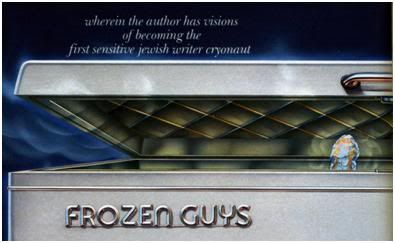 There are also articles from the late 1980s documenting the Dora Kent incident, though the record as represented here is far from complete:
There are also articles from the late 1980s documenting the Dora Kent incident, though the record as represented here is far from complete:
Most of the first (still extant) newsletters of the Cryonics Society of New York (CSNY) are present starting in 1966 and going forward until Immortality, the successor magazine to the original Cryonics Reports ceased publication :
http://cryoeuro.eu:8080/download/attachments/425990/Cryonics+Reports+2%289%29+1967.pdf
http://cryoeuro.eu:8080/download/attachments/425990/CryonicsReports3%2810%291968.pdf
http://cryoeuro.eu:8080/download/attachments/425990/Cryonics+Reports+2%285%29+1967.pdf
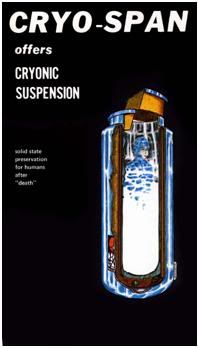 Promotional material from the early days of cryonics, such as the full color Cryo-Span brochure have been carefully scanned and restored:
Promotional material from the early days of cryonics, such as the full color Cryo-Span brochure have been carefully scanned and restored:
http://cryoeuro.eu:8080/download/attachments/425990/CryoSpanBrochure.pdf
The full proceedings of the First Annual National Cryonics Conference which was held in 1968 is also available:
http://cryoeuro.eu:8080/download/attachments/425990/Proc1stAnn+Cryo+ConfNYC1968.pdf
Isamu Suda’s Nature article documenting his claim that cat brains can recover EEG activity after days of frozen storage at -20oC was used by CSNY (and all succeeding cryonics organizations) as a promotional tool, and a copy of that article, as distributed by CSNY is present:
http://cryoeuro.eu:8080/download/attachments/425990/SudaNature1966.pdf
I believe that all of the issues of the Chamberlain’s extraordinary effort, Manrise Technical Review, are presented and accounted for. A sampling is here:
http://cryoeuro.eu:8080/download/attachments/425990/ManriseTechRev1%281%291971.pdf
http://cryoeuro.eu:8080/download/attachments/425990/ManriseTechRev3%281%291973+.pdf
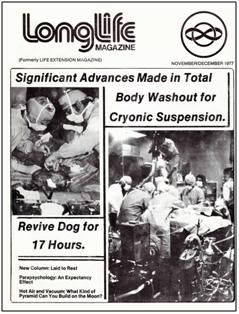
With the exception of the last 2 issues, all of Life Extension, later to become Long Life magazine has been scanned. Yes, that’s right; there was both a Life Extension, and a Long Life magazine long before the current efforts by the Life Extension Foundation and the Cryonics Institute:
http://cryoeuro.eu:8080/download/attachments/425990/Life+Extension+Magazine%2C+1%281%291977001.pdf
http://cryoeuro.eu:8080/download/attachments/425990/LongLifeMag2%285%2910_1979.pdf
A few issues of the complete Cryonics (1980s) magazine (with illustrations) have been scanned.
http://cryoeuro.eu:8080/download/attachments/425990/CryonicsMagJune9%286%291988.pdf
http://cryoeuro.eu:8080/download/attachments/425990/CryonicsMagJune9%286%291988.pdf
Since I was informed that Alcor will shortly be scanning and uploading these issues of Cryonics to their website library, I have not proceeded further with this arduous task. [Because I am using a flatbed scanner which will not accommodate 8.5” x 14” images, each issue of Cryonics that I scan must be completely disassembled – aligning the pages is also an onerous task.]
The original, professionally published (color cover) of Cryonics: Reaching for Tomorrow is present, as well as this prototypical 1989 version:
http://cryoeuro.eu:8080/download/attachments/425990/AlcorReachingForTomorrow1989.pdf
There are also a fair number of scientific journal articles relating to cryobiology, cardiopulmonary resuscitation, cerebral resuscitation, cerebral ischemia and liquid ventilation, which are likely to be of interest only to researchers working in these areas. One classic paper which deserves mention is the original work of Ames, et al., documenting the no-reflow in the brain after cardiac arrest[2]:
http://cryoeuro.eu:8080/download/attachments/425990/amesnoreflowii1968.pdf
Considerations Past, Present & Future
There is a staggering amount of material still in need of scanning – literally thousands of pages. I’ve tried to digitize the documents that seemed most historically relevant; but that is my subjective judgment and it is no doubt deeply flawed.
There will be accidentally omitted pages and other errors in these documents. These are mostly raw, unedited scans. There was no one to proof my work when I first undertook it, and that is still the case today. I apologize for errors or omissions but also want to be note that I did the best job I could, given my personal and technical limitations.
In many instances, documents which still remain to be scanned, exist as the only copy. This is a dangerous situation: several years ago the plastic sprinkler pipe in our home froze while we were away, inundating the whole house with countless gallons of water. Some of the archival material (fortunately a very small fraction) were damaged, and some (a few items) were completely destroyed. The bulk of the archive was saved because it was stored in closets that were largely inaccessible to the 3-day long downpour from the ceiling. Since then, the materials have been repacked in covered plastic bins. Whilst this makes ready access very difficult and time consuming, it was a necessary tradeoff.
Dr. Mike Perry is similarly slowly laboring to digitize the cache of material he has accumulated. Sadly, a significant fraction of the CSNY archive was sent off to Underground Vaults and Storage in Kansas, and I’ve long since given up hope of seeing it again anytime soon (the cost of retrieval is ~$2,000). Mike has digitized all of Ev Cooper’s Life Extension Society newsletters Freeze-Wait-Reanimate as well as the all of the Cryonics Society of Michigan (now the Immortalist Society/Cryonics Institute) newsletters The Outlook and The Immortalist. Hopefully these will be available on-line soon, as well.
I will add to this archive as I can and I would encourage others to do so as well. If you have media articles, literature, correspondence, photos or items you think might be of historical import to cryonics, please contact either Eugen Leitl (eleitl@gmail.com) or me.
Footnotes
[1] I was President of Alcor from 1982 to 1988 and a critical force in management until shortly before my departure in 1992.
[2] After ~ 6 minutes of cardiac arrest it becomes difficult bordering on impossible to restore blood flow to the brain under normal clinical conditions. Even now, over 30 years later, the mechanisms which underlie the no-reflow phenomenon are not fully understood.

I wonder if cryonics in 2011 suffers partly because of its association with a lot of the bad futurology produced in the latter 20th Century. It has apparently acquired a damaged-goods reputation, if recent writings about “the future” tell us anything. Circa 1990, Ed Regis’s Great Mambo Chicken treats cryonics ironically, but at least he lets cryonicists have their say. By contrast, Mark Stevenson’s similar book, An Optimist’s Tour of the Future, which came out this year, dismisses cryonics early on in one paragraph by comparing it to Alex Chiu’s immortality rings. Michio Kaku’s Physics of the Future, which also came out this year, doesn’t mention cryonics at all, despite his support for the possibility of radical life extension.
While some people with largish internet followings have advertised their cryonics arrangement (Patri Friedman announced his the other day), on the whole the cryonics idea seems to have lost what little ability it had to communicate effectively. Instead of heading in the direction of borderline social acceptability, cryonics’ ability to signal weirdness and defection from social norms seems to have strengthened in recent years.
Quite honestly, I don’t the answer to your questions. With the possible exception of the four years between 1964 and 1968, cryonics has never had a good time of it. My experiences of cryonics, beginning in 1968 and continuing through the present are necessarily subjective. Nevertheless, I did live through those years and there are still a few others around who lived through them as well who can be asked for their opinions. From 1969 on it was horrible; basically a slow downward spiral, both within and without. This began to change for the better with the creation of Trans Time and Manrise, but the benefit of that was not really widely felt until the mid-1970s.
I wish that I had a much larger and broader collection of scanned media articles available from that era (and from all eras in cryonics). After Chatsworth, which hit in 1975, there was devastation to cryonics’ public image and that was reflected both in membership growth and in the number of patients. I remember Art Quaife saying at one point that it was surprising at how long it had been since anyone had been frozen – a fact he attributed to Chatsworth. Particularly in books, I repeatedly remember reading about cryonics in the past tense – full stop – no equivocation: along the lines of “Cryonics was a fad that was practiced in the late 1960s through the mid-1970s…It was later discovered that all the frozen bodies had been allowed to thaw out and decompose.” End of story.
I think the best way to get a feel for the reality of how cryonics has fared over time is to spend the time actually looking over the historical record, more or less chronologically. It’s regrettable that books, TV and radio programs are not also available for perusal, but the media articles and the newsletters of the various organizations serve as a reasonably good record. As an aside, one of the really shocking things to me was to realize that most of the people mentioned in the pages of Cryonics Reports are dead or cryopreserved (mostly dead). The situation is not much better with respect to Life Extension/Long Life magazine (LLM). Here’s a shortlist of the now departed (that I know of) contributors to LLM : Pat Dewey (editor), Thomas Donaldson, F. M. Esfandiary, Jack Erfurt, Andrea Foote, Jerry Leaf, Jerry White, Paul Segall, Hugh Hart, Timothy Leary, Joseph Still, Steve Rievman, and Ben Schloss. If you do the mean of the life span of the hardcore cryonicists on that list, you get 59.1. Maybe cryonics isn’t good for us? That, BTW, is what the mean lifespan was in the US circa 1925!
Cryonics is to a great extent what we make of it. If we do interesting and exciting things, we’ll attract interesting and exciting people. We had our only period of exponential growth in the 1980s when we were doing productive and exciting things, including large animal survival research, developing new paradigms to communicate the idea of cryonics with, being heavily involved with the world and the cutting edge (i.e., nanotechnology), and setting and achieving ambitious goals in terms of patient care and security. There was good energy around cryonics at that time. In fact, it is ironic but not surprising that both of the current CEOs of CI and Alcor were recruited during that period. Interesting and exciting people attract people, period. That isn’t glamorous, but I suspect it is the reality. Oh yeah, one more thing, you do have to tell people what you are doing and get them involved. — Mike Darwin
>being heavily involved with the world and the cutting edge (i.e., nanotechnology)
So much for that “cutting edge.” By contrast, the scientists who went into genome sequencing and research in the 1980′s have something useful to show for their efforts.
Some facts and some thoughts. When cryonics pretty much introduced the word (and the general concept of nanotechnology) in Cryonics magazine in the 1980s, it was a powerful, cutting edge idea and a powerful cutting edge technology. Small “n” nanotechnology still is. I believe it is still the case that most of the educated people on this planet now alive were raised being taught the ABSOLUTE dogma that it would forever be impossible to “see” or image atoms. I remember being awestruck when the IBM logo was spelled out with xenon atoms on a nickel crystal at LN2 temperature using an STM . That was revolutionary and important far beyond the PR feat for IBM.
It is also the case that many of Drexler’s ideas were and remain “cutting edge” and powerful. Any unbiased reading of ENGINES or NANOSYSTEMS reveals first-class and paradigm shifting ideas in basic science and in the future of applied technology. So what he didn’t get all of it “just right” or that the milestone dates are ludicrous in hindsight? That’s par for the course in any kind of technological forecasting and nowhere has that proved more true than in cryonics itself! In fact, it has proved true in cryobiology! Lillehei was predicting the revival of intact dogs from cryopreservation by 1980 or 1990, and even some of the most conservative cryobiologists who were rabid critics of cryonics in the 1960s and 1970s were confidently predicting solid organ cryopreservation and organ banks by 1990 or 2000. Seriously, you should read FUTURE BABBLE: the track record of even eminent experts predicting the relatively near term future of their field is terrible – ludicrous really. Nanotechnology has nothing to be ashamed of in that regard.
And yes, it is true that a cult of Nanotechnology, as opposed to nanotechnology, grew up in the 1990s that was moderately pernicious and consisted of a subgroup of people who made specific (and unlikely) technologies and their timelines more or less dogma. It was “dangerous” to disagree with such people, Merkle being the most prominent. Criticize Ralph Merkle, and your views were marginalized and you were considered akin to being seditious. THAT was destructive, but its origins can be traced back to cryonicists in the early 1990s who knew a good propaganda tool when they saw it, and simply didn’t know (or care) what the long term consequences would be of using it indiscriminately.
Today, nanotechnology is everywhere in materials science, electronics and yes, even medicine. No, there aren’t itsy bitsy universal assemblers or cell repair machines, but there are an impressive array of drug delivery and other therapeutic systems that rely on nanotechnology, and there are stunning advances in electronics and materials science that depend upon it, as well. Look at the N-gram for nanotechnology: http://ngrams.googlelabs.com/graph?content=nanotechnology&year_start=1980&year_end=2011&corpus=0&smoothing=3 . That’s impressive. If you look at the predictions in the annual reports of most corporations, or the performance projections of life insurers or investment bankers, well, these people shouldn’t have a shred of credibility left. They are even more culpable for bad predictions because they make the same ones over and over and over! And they are virtually never called on them.
Cryonics has been a laughingstock almost since Day One. One of the really frustrating things about the near total and long lasting administrative dysfunctionality at Alcor is that sitting in the CSNY archives at UVSI are the tape recordings of a number of the radio and TV shows from 1966-69. Ettinger on the Tonight Show with Johnny Carson is PAINFUL to listen to, and it was agony to watch. Buddy Hackett (then a popular comedian of the time) and Zsa Zsa Gabor, made a mockery of cryonics (and of Ettinger). And the audience was eating it up. Look at the N-gram for cryonics and my commentary on it: http://wp.me/p1sGcr-7O . The REAL and CATASTROPHIC damage to cryonics was done by cryonicists. Chatsworh halted and reversed the growth and credibility of cryonics for a solid decade between 1976-1986. I think a case can be made for the Ted Williams case having done the same. Both of those cock-ups were solely our doing and our responsibility. The way the Williams case was pursued violated not only common sense, but several core and absolute Alcor policies, such as the requirement for paperwork in advance of receipt of the patient, no 3rd party funding, the requirement for payment in advance, the special requirements that pertain if there are hostile family or a high media profile, and on and on. As to a crook letting the majority of the then extant cryonics patient population rot away under everyone’s noses with impunity, and with outsiders being the one to blow the whistle, well, what can be said out that, other than STUPID and TOTALLY IRRESPONSIBLE.
It’s easy and convenient to scapegoat the nanotechnology people, or anyone else who has what turn out to be improbable ideas about the future. However, mostly it is neither fair nor productive. To the extent these people and ideas caused us harm, we were (and are) complicit; and it is ultimately our responsibility to be selective and critical in our promotion of ideas like nanotechnology. Cryonics has never been respectable, and it is unlikely to be so anytime soon. As dismal as progress has been, there has been progress and, absent our own fuck-ups, it has been steady – and at times impressive.
Finally, look at the information output from Alcor these days (and for the past 15 years) and just as importantly at the LACK of it. There is more info here on Chronosphere in a month than they output in 6 months. And there is now zero transparency about things like technical procedures used, research, finances, and many, many other basic questions that smart and responsible people considering cryonics will have. I’m working on an article now, and I have 16 questions written down that I need the answer to from Alcor, including where is the financial report for 2006 and where are financials for the last 4 years? I have dozens of specific technical and administrative questions that I consider routine and non-controversial, and many more about planning, strategy, promotion and security. I’ve learned not even to waste the bytes and the electrons, let alone the time and effort, asking them. My correspondence with Max More is fascinating in that the most critical issues are never acknowledged, let alone addressed. Alcor patient’s get prolonged interrupted CPS under conditions of mild hypothermia; not a word from Max, not, “Oh no! How can we fix that?” or “Are you certain that this is the case, because the graphic (or tabular) data I have says otherwise?” And when I publicly call him on that, and many other equally important issues, I’m accused of treachery and of smearing Alcor.
No, the worst harm to befall us we’ve done to ourselves. We’ve invited the Avi Ben Abrahams, the Bill Haymakers, the Bob Nelsons and the countless other goofballs, quacks and charlatans into our tent and made them right at home. We hired a guy whose previous endeavor was searching for Noah’s Ark to be President of Alcor, as well as a bigoted incompetent who allowed an embezzler to steal tens of thousands of dollars from us. Blame others? Hell, we should be ashamed to show our faces in public. — Mike Darwin
We hired a guy whose previous endeavor was searching for Noah’s Ark to be President of Alcor.
Who the hell was this?
I’m really laughing as I sit here, and that is saying something, because I’ve had refractory dysentery for weeks. Aschwin de Wolf recently wrote something to the effect that cryonics might be in better shape were it not for “the bizarre hiring practices of certain cryonics organizations.” Listen, the reality of what has gone on there at Alcor defies words, and largely defies understanding. If I tried to relate half of what I know first hand, which is but a small part of the whole crazy reality, I simply would not be believed. In trying to understand what happened, one factor (among many) that should not be overlooked, is that prior to ~ 1990, there was no money in cryonics. By that, I mean that the people pursuing it as a “profession” worked their asses off and they got paid very, very little – basically a subsistence wage that, per hour, worked out to well under minimum wage at the time (i.e., $15,000 in 1987 dollars).
Once money became available, really big money, primarily from Dick Jones’ estate and from LEF, then it became possible to pay good money – market rate or better – for personnel. The Jones money was the primary impetus for this and as soon as it began to flow, what you call the “GenX Cyberpunks,” strongly supported by Carlos Mondragon, began to demand more money, in addition to full benefits. In principle there was nothing wrong with this. However, the money had the reverse effect of what would be expected; it decreased productivity. As just one example, one staff member decided he would be “more creative and less distracted” if he worked at home (it was crowded and noisy at Alcor in those days). So, he was allowed to work at home. The net effect of this was that Cryonics went from being a monthly periodical to a bimonthly one… I later heard that this employee was actually playing computer games at home and bumming around Riverside during his “home work days.”
Money also made “quick fix schemes” possible (or at least affordable). When Alcor cases began to be fouled up because critical supplies were missing or out of stock in the OR, the solution was to purchase a then ungodly expensive bar code inventory system. To my knowledge, this was never put into service. More to the point, there was no need for it. Jerry and I never had a situation occur where there were critical supplies missing because we had a good “feel” for what was on hand and we had a perfectly pedestrian paper inventory system that worked. A good short order cook in a restaurant may (rarely) run out of a necessary item if business is way over what is expected, but he doesn’t come into his kitchen on a routine basis and find he is out of eggs or potatoes or butter… That is because he actually works there every day! We were doing animal work and we knew what we had on hand – to not have a stock of 1/2″ to 3/8″ connectors, let alone not to have even one, was not even conceivable to us. Those who followed us, well, what did anyone expect?
And that leads me to my last points here. I was absolutely dumbfounded at the ease with which most of the members were willing to entrust their care to people with no experience and no inclination to get any. It was very much like seeing the members of a ‘surgical cooperative’ decide that the office secretary would do just fine replacing the neurosurgeon and that an Army band member could pinch hit for the perfusionist on the cardiac surgery team. While my paper qualifications were nil, I was still astonished, and I think it was only then that I really began to understand just how little technical competence (leaving excellence out of it) was valued in cryonics, and thus just how little I was valued. These incompetents, lazy incompetents, in fact, would have never stayed around, let alone worked in cryonics, if it didn’t pay extraordinarily well for doing little or nothing – and with benefits included! By no means was it the money alone, but the money did make it possible. If Alcor were the sole example of this phenomenon, I’d be less of a believer in money as a corrosive factor. However, I have seen it over and over again in cryonics and I am afraid that it is all too real. — Mike Darwin
Since you mentioned the “nanotechnology” mirage, I worry about cryonics’ current association with the transhumanist/singularitarian fad, which I suspect will run out of juice in a few years when it becomes clear that the imaginary technologies just won’t arrive.
For example, I recently read a book about Watson and Jeopardy, which shows that it took the resources of a major corporation, the efforts of a lot of very bright people and a lot of debugging to get a product which could hold its own in a game show. Yet a high-school dropout with a phony “institute” who has never held a real job, or worked on a real software project that I know of, has conned a lot of otherwise intelligent people into believing that he can create an imaginary technology called the “friendly AI” which can solve all of our problems, including revival from cryostasis. (He even compares himself to the creator of the fictional “godlike entity” called Primus in the Transformers franchise.) Yet he shows signs of becoming one of the better known cryonicists in the coming years. When his impostures blow up in his face, will that also further damage the public perception of cryonics?
I’m kind of sick of your unfair attacks on this particular organization, which you don’t seem to understand…
I often recognize phony people when I encounter them. You learn a lot about real human behavior, especially its uglier aspects, by working in business and dealing with the public.
BTW, Luke, I didn’t make up Eliezer’s remark about creating Primus. Perhaps he said it in jest to entertain Patri’s son; but if he said it seriously, it does suggest that he has some grandiose delusions about his abilities.
Pretty much the only things I know about Elizer Yudkowsky are what I just read on the web, and several articles he was written, one of which I just cited a few days ago in an upcoming article I’m working on. BTW, that article, on the psychology of bias in technological risk assessment, is excellent, IMHO. I’m not impressed with institutes to create friendly AI, nor was I impressed with the Foresight Institute, nor do I think a technotopian Singularity is near. However, there is only so much time and so much bandwidth and I don’t think our focus here should be Yudkowsky. I think the point has been made that this kind grazing off grass not yet grown offends some. Fair enough. But time to move on. As cryonicists we have palpable problems and very real enemies – people who actively want to and are working to hurt us. We need to be focused on setting our own house in order, first and foremost
One last point. Despite not having any, I do pay attention to degrees and credentials. They are a good general indication of the POSSIBILITY of competence. A cardiac surgeon who never went to medical school, or dentist who is an autodidact, are not people I would normally have truck with for my health care. However, there are exceptions. I would never have had Jerry Leaf do a coronary artery bypass graft on me, unless I really needed one and he was the only guy around. He was a competent basic cardiac surgeon, but he wasn’t fast (and that’s important!) and he lacked the depth of experience of a skilled cardiothoracic surgeon. Going further, given a choice between a skilled cardiothoracic surgeon and Jerry Leaf to operate on me for my cryopreservation – well, it would have been Jerry hands down, because he was a staggeringly good cryonics surgeon. Jerry had a B.S. in Philosophy. There are plenty of people in this world whose illiterate ramblings would definitely make the absence of a high school diploma material in judging their deficits. In Yudkowsky’s case, the presence or absence of a HS diploma is, again IMHO, immaterial in the arena in which he is operating. I might not hire him as a fry cook or a cell biologist, but that’s neither here nor there. He clearly has mastery of the language, native intelligence, and the ability to persuade people to give him money (no small feat, that). I also note that he is forthright in acknowledging his educational limits. Ray Kroc (whom I once met & was tremendously impressed with), Richard Branson and Alan Sugar are/were billionaires absent a secondary school education. Peter Jennings and the Wright Brothers also come to mind. In the arenas of highly successful film and music performers I often wonder if the number of HS dropouts isn’t greater than the number of graduates. — Mike Darwin
mark wrote:
=============
While some people with largish internet followings have advertised their cryonics arrangement (Patri Friedman announced his the other day),
========
hmm…this patri friedman is a seasteader. That is an oddball freak in mainstream society by almost any measure.
—————–
on the whole the cryonics idea seems to have lost what little ability it had to communicate effectively. Instead of heading in the direction of borderline social acceptability, cryonics’ ability to signal weirdness and defection from social norms seems to have strengthened in recent years
————
I think that is completely accurate and a very important thing to realize.
People who go on the internet to write about cryonics do not seem to understand how freakish it seems to 99 percent of other americans.
Look, among the people I know and work with, even educated people–lawyers, judges etc–cryonicists are freaks to them. They are literally afraid of having anything to do with them, even being associated with it in any way.
And even among ordinary people who use the internet, to read ideas like this on the internet is foreign to them–they use the internet to keep in touch with other humans, and they use things like facebook to do that.
What is holding us back is our inability to see just how different we are from the 99.9%
I have some reservations about Patri’s idea as well, but it fits into the trend among society’s alpha producers to tell progressive politicians to keep their hands off their money and go fuck off, as they look for other places to move their citizenship, businesses and wealth where the governments offer to treat them better. Basically the Sovereign Individual/Five Flags/Perpetual Traveler movement views countries like competing hotels; you want to find the ones which accommodate you and make you feel appreciated at competitive prices (taxation). Seasteads could enter into this market and draw substantial amounts of wealth in their direction.
@Abelard:
http://www.baptiststandard.com/1999/6_9/pages/ark.html
Jerry Lemler? I thought he was one of the better CEO’s of Alcor, at least compared to who came after. Yes, I know Lemler was into this kind of stuff. But I met they guy in person and thought he was a decent sort. Of course, he’s trained as a psychiatrist and, by virtue of that, is going to have better “bed-side” personality than most others.
I had a bad vibe about Dr.Lemler when he started to post strange things on the old Cryonet. Johnson’s book also supported things I heard about him from other sources, for example, that other people at Alcor didn’t respect him.
As to the larger question about the history and appeal of cryonics, I think it has always had a dodgy image, even in the early days. The growth of the 80′s was fueled by a combination of factors that no longer exist. Alcor did its best research at this time, which happened to be when bio-engineering and nanotechnology was first discussed. It was the promise of these technologies that promulgated interest in cryonics among the space movement that existed at the time (L5 Society). The space movement faded starting in the late 80′s and nanotechnology got hyped up into (N)anotechnology by the gen Xer computer people, who entered the scene in the early 90′s.
I visited Alcor at the end of 1993 when it was under the domination of the Gen Xer cyberpunks (it was still in Riverside at the time). I was not impressed with them. They may have had good computer knowledge, but their knowledge of biology and materials was rather limited.
BTW, Real nanotech is showing up in all kinds of products, ranging from drug delivery to skin creams. There is a big push in the semiconductor industry to develop molecular electronics based on self-assembly chemistry to take over when the CMOS scaling reaches its limits (7nm level) later in this decade. The high vacuum thin-film techniques (deposition, patterning, and etching) cannot go below 7nm and may even be limited at 10nm. Moore’s Law ends in another 5 years or so unless they develop self-assembly fabrication. Lots of money is on the line here.
Peter Thiel’s sea steading concept is not that far out. All he is envisioning are the floating versions of Hong Kong and Singapore. There are technical hurtles to overcome, but the social, economic, and political models have been around for centuries, in the form of the city-state. All Thiel wants to do is make floating city-states.
I don’t care what other cryonicists think, Mike. I appreciate your efforts to digitize all that archival material. I subscribed to Long Life and Life Extension magazines for a couple of years in the late 1970′s. After reading through parts of them again, their energy and enthusiasm strike me, despite their hand drawn illustrations and cheap formats. I just don’t see that in Alcor’s and CI’s respective magazines now.
While my paper qualifications were nil, I was still astonished, and I think it was only then that I really began to understand just how little technical competence (leaving excellence out of it) was valued in cryonics, and thus just how little I was valued. These incompetents, lazy incompetents, in fact, would have never stayed around, let alone worked in cryonics, if it didn’t pay extraordinarily well for doing little or nothing – and with benefits included! By no means was it the money alone, but the money did make it possible. If Alcor were the sole example of this phenomenon, I’d be less of a believer in money as a corrosive factor. However, I have seen it over and over again in cryonics and I am afraid that it is all too real.
Michael,
Unfortunately, what you describe here is an apt description of the the entire U.S. business culture and economy. It is the existential reason for the current “long” recession and why it will last at least 10 years (just like Japan after its bubble). Its a real pain in the ass for anyone who wants to make money doing anything real. I worked for two employers since my return in 2001 and both of them were utterly screwed up operationally. There’s a reason why things turned out this way, but its too long to explain here.
Dear Mr. Darwin,
I am historian and sociologist of post-WWII science and technological innovation, writing my Ph.D. dissertation at the University of Illinois at Urbana-Champaign. I would like to send you a letter outlining my work on the place of cybernetics and the cyborg sciences in the writings of cryonics progenitors Ettinger, Cooper, and Prehoda, and my interest in the historical record of cryonic suspension generally. Is there a mailing or email address I could send the letter to?
Very Best,
Grant